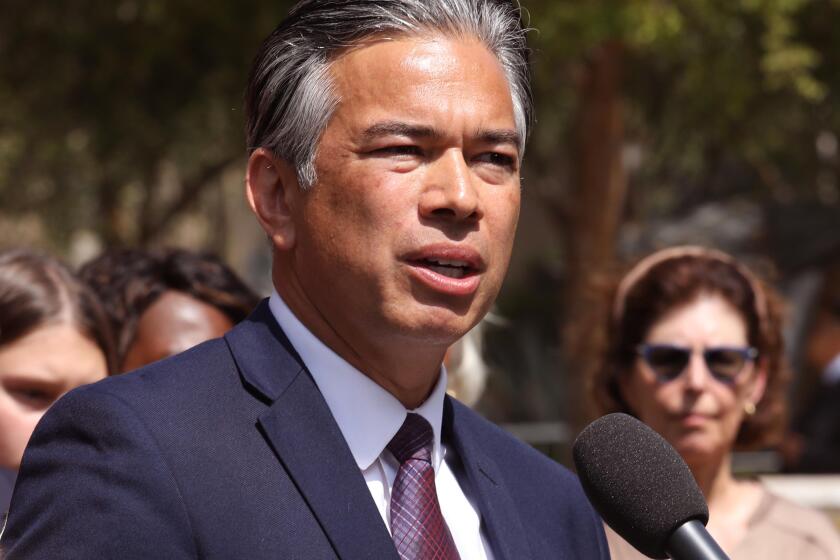Letting Their Fingers Do the Voting
- Share via
RIVERSIDE — There’s something new in the elections business, and voters in Riverside County this week can put their fingers right on it.
Video touch screen voting machines made their California debut Tuesday, giving local election officials hope that in time, voting will be easier, quicker and cheaper than ever.
The machine’s screen displays each contest and as the voter presses a finger against the appropriate box, other options in that race disappear. Voters can change their minds before submitting their final electronic ballot.
About 30 machines are being used by absentee voters this week in local Riverside County elections, but officials plan to install 4,500 of them in time for the November 2000 election--making Riverside the first county in California to endorse their wholesale use.
Riverside officials say that the machines will ultimately pay for themselves by saving the cost of paper ballots. They will also, officials say, lead to a quicker tabulation of votes.
Election officials in other counties are taking a “wait and see” attitude.
In Los Angeles County, touch screens may be used at select locations for absentee voting in November 2000, but Registrar Conny McCormack said she is not yet convinced that the machines would be more economical than the punch cards used by her department.
“It’s still pretty new technology,” McCormack said, “and with technology constantly changing, we may be able to jump in later with something that’s less expensive.”
In Orange County, officials have been informally reviewing touch screen voting systems but are not rushing into a decision, said Assistant County Registrar Don Taylor. “It’s very clear that voting is moving toward more automated systems,” he said. “But we’re not ready to at this point because of the cost [about $3,500 per machine].”
The secretary of state’s office certified the use of the machines after their accuracy was tested by an independent laboratory--and voting laws were changed effective this year to accommodate them, said spokesman Alfie Charles.
Previously, the names of write-in candidates had to be written in by voters; now voters will be able to type in the names of write-in candidates, using a touch screen keyboard.
“It’s hard for us to promote one election system over another, but one that provides an easier method of voting has obvious benefits and will cut down on voter mistakes--such as punching the wrong holes or over-voting,” Charles said. “Riverside County is leading the way in California to implement new technology that will make the voting process a little easier.”
The decision of counties to adopt touch screen voting is based largely on economics.
Riverside opted for the touch screens because its current voting system--in which ballots are scanned optically by computers--requires the printing of multiple ballots reflecting different combinations of measures and races. The cost can exceed $2 per voter--and depending on voter turnout, more than half the ballots are unused and thrown away. In Los Angeles, on the other hand, the same generic punch card can be used by all voters, costing 7 cents each.
The Riverside County Board of Supervisors has authorized the purchase of 4,500 machines for use next year, at a cost estimated at $13.5 million.
In Dallas, touch screen machines were introduced last November and in exit surveys, more than 90% of the voters approved of them, said Dallas County elections administrator Bruce Sherbet.
“The over-55 population liked it better than anybody,” he said. “They loved it because the process was so easy.”
Several companies manufacture touch screen machines, which have similar features. Among them: the on-screen ballots can be displayed in any required language.
The votes are recorded in an electronic cartridge that is removed and delivered to a central computer for election night tallying. Each machine also maintains, within the unit, an electronic backup copy of all votes cast, and produces a paper printout recording of the votes.
Although the machines may make voting easier, experts say it will not necessarily make voting more popular.
“There are two kinds of groups: people who vote, and those who don’t,” said Allan Hoffenblum, a Republican Party political consultant. “Those who vote don’t really care about the method as long as it’s convenient and easy. And it doesn’t get any easier than requesting an absentee ballot and voting at home--and even then, not everyone who asks for one actually votes.”
More to Read
Get the L.A. Times Politics newsletter
Deeply reported insights into legislation, politics and policy from Sacramento, Washington and beyond. In your inbox twice per week.
You may occasionally receive promotional content from the Los Angeles Times.










